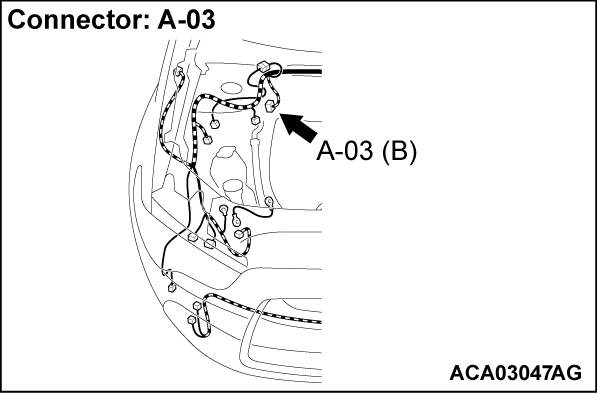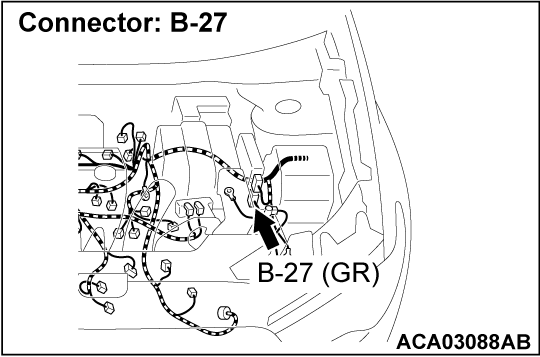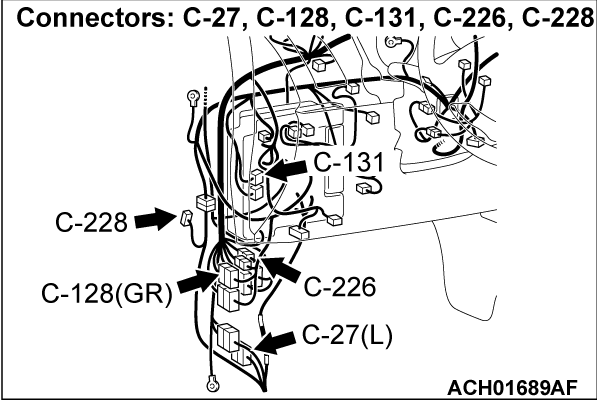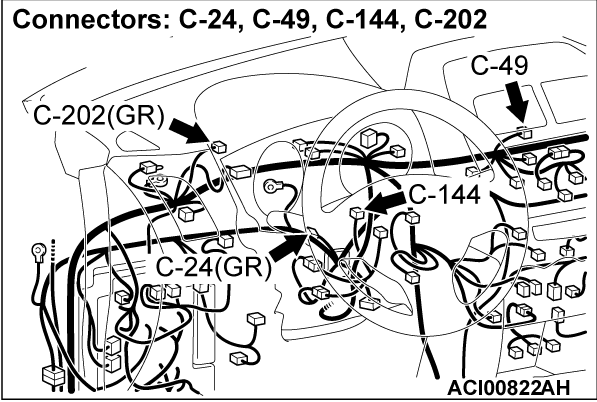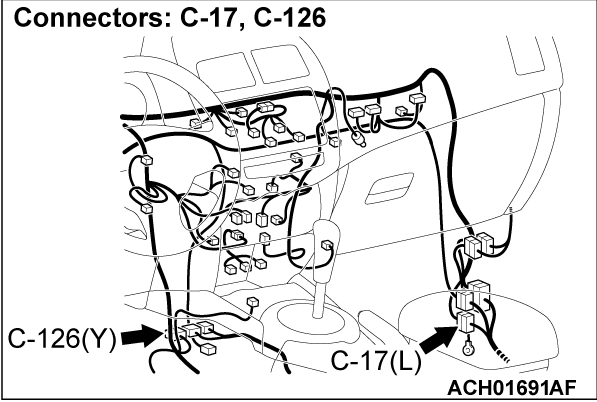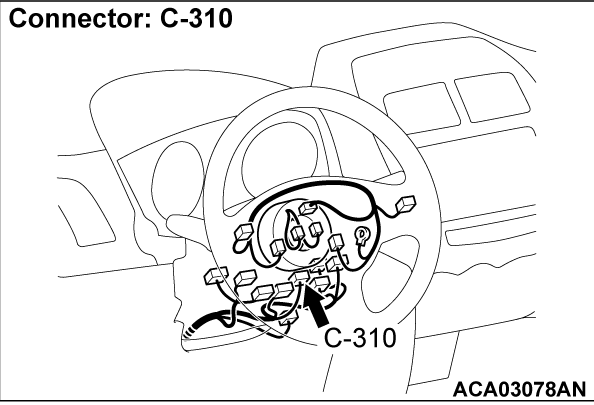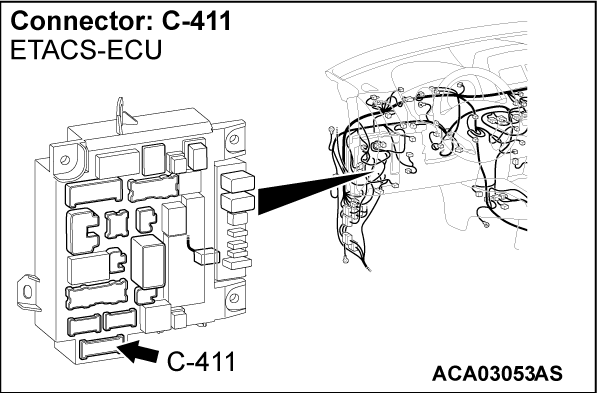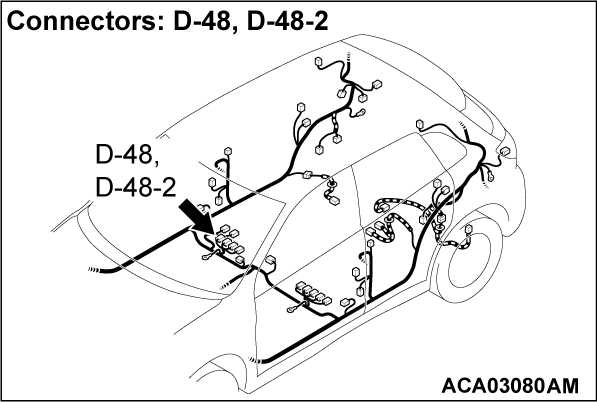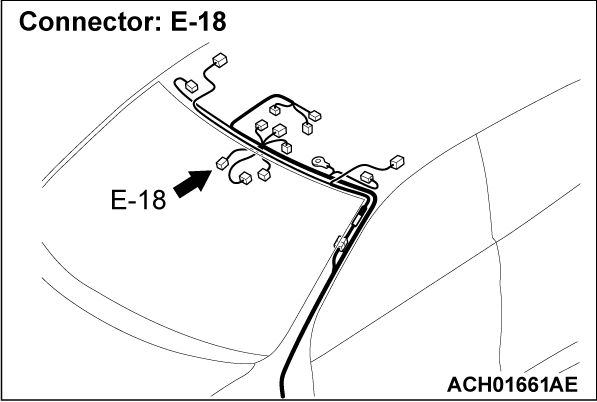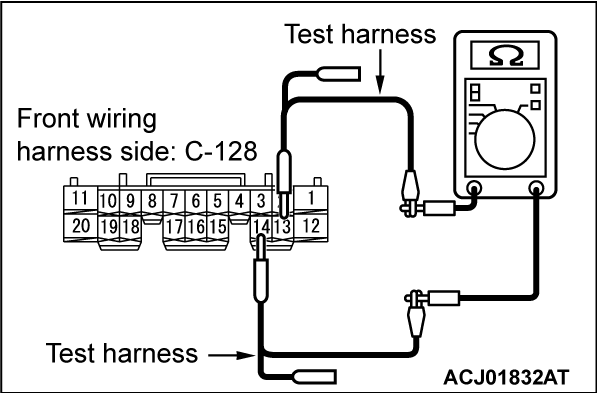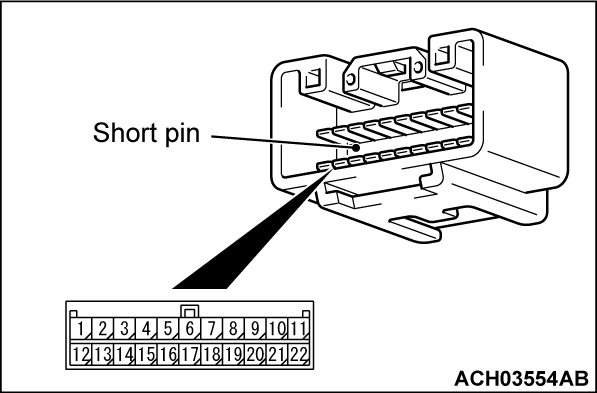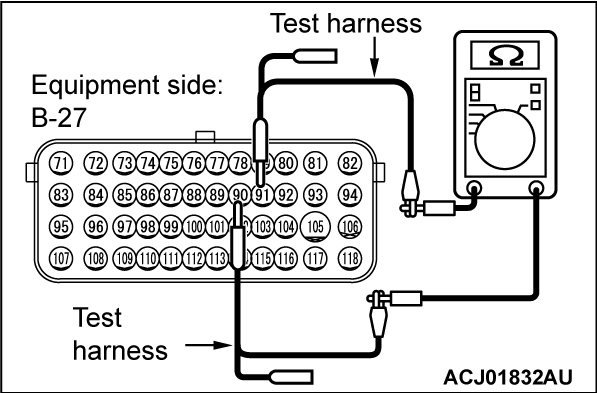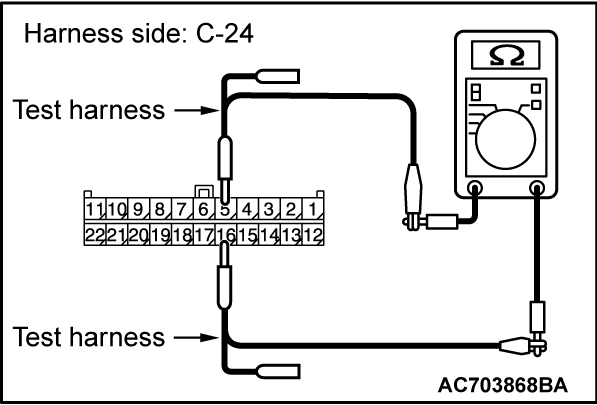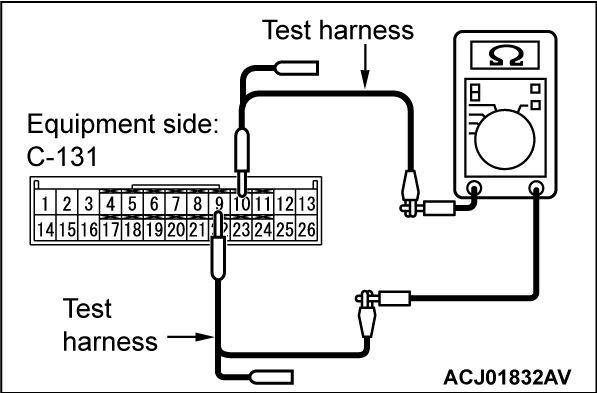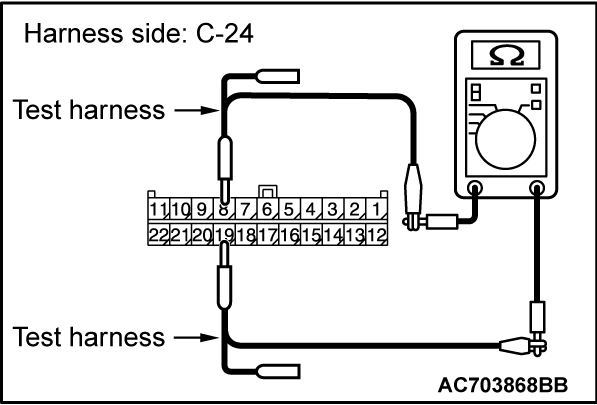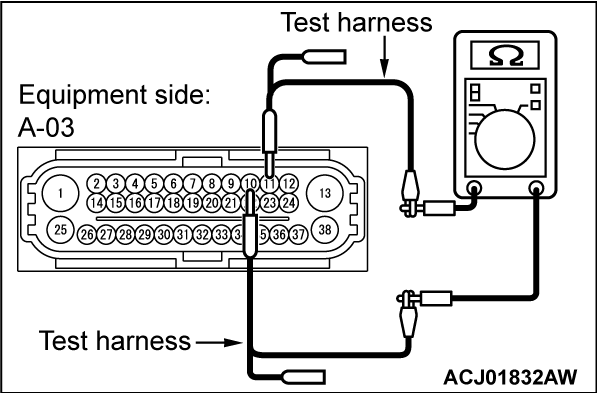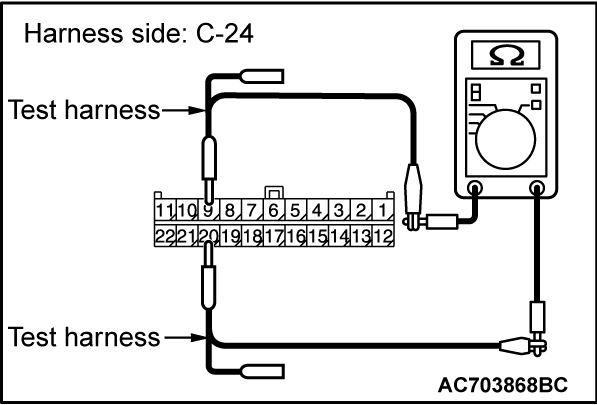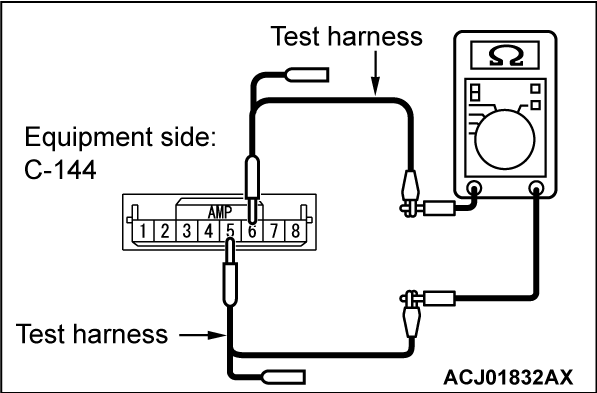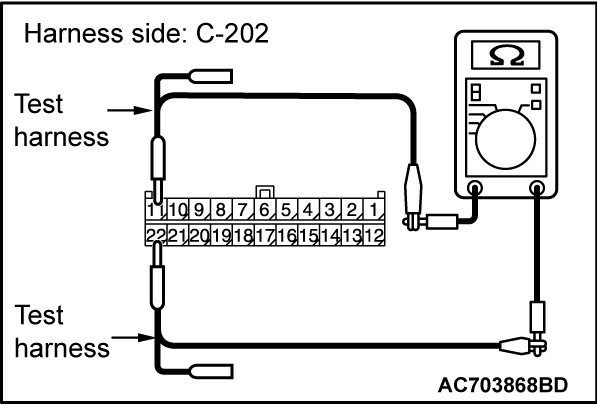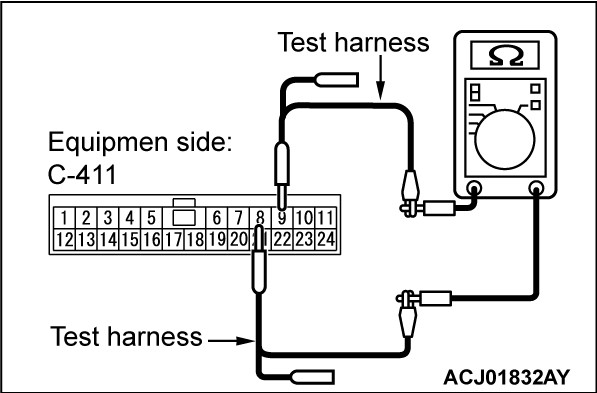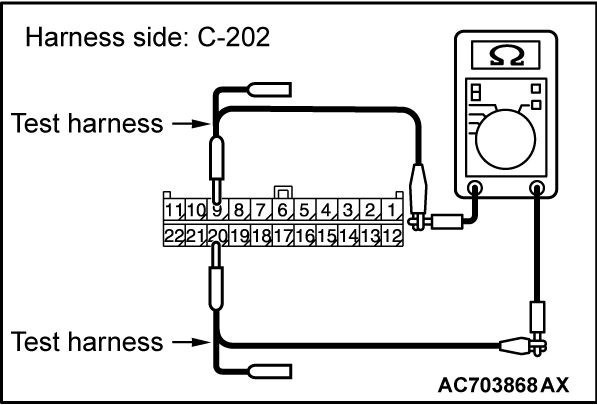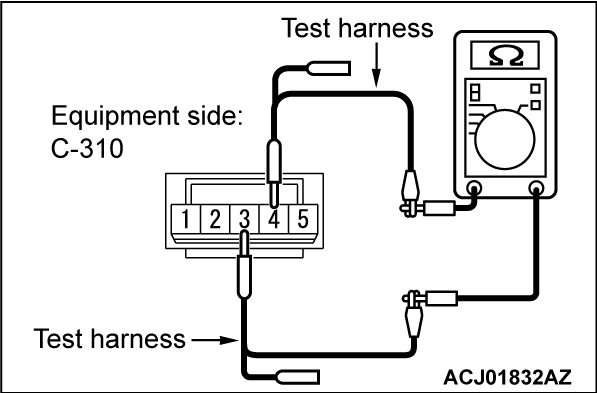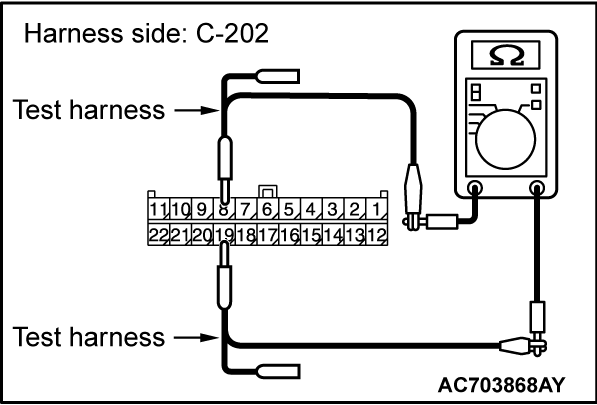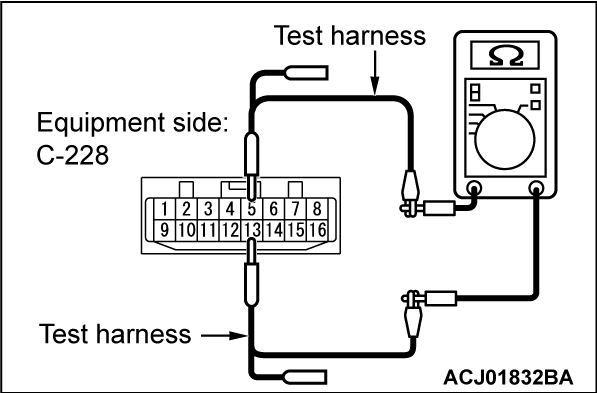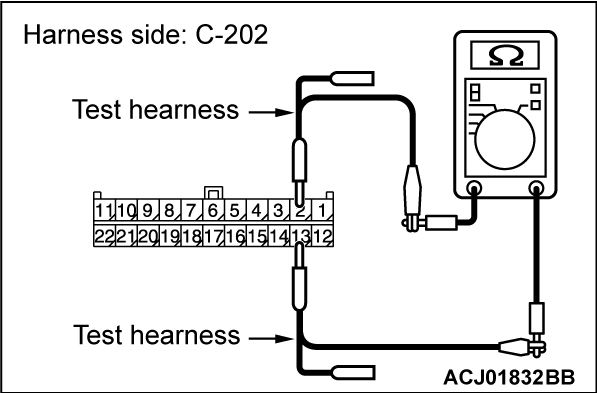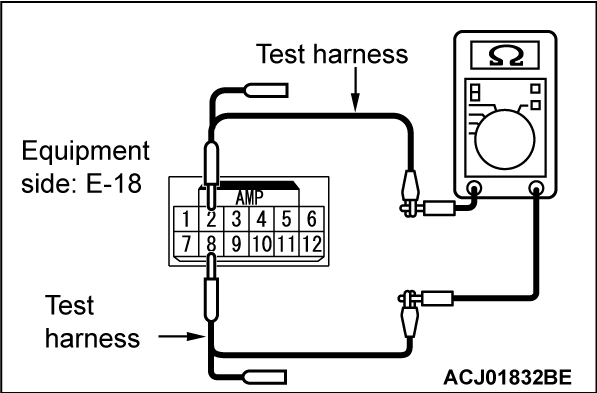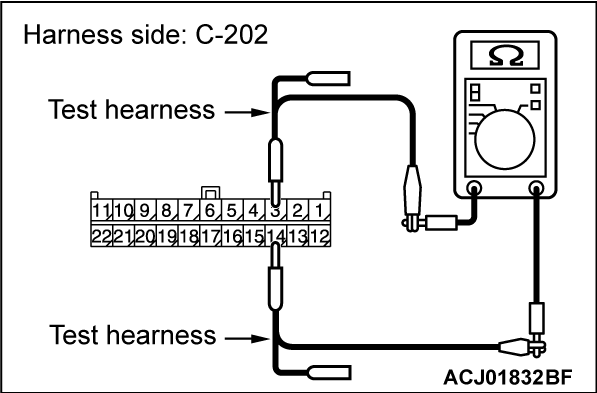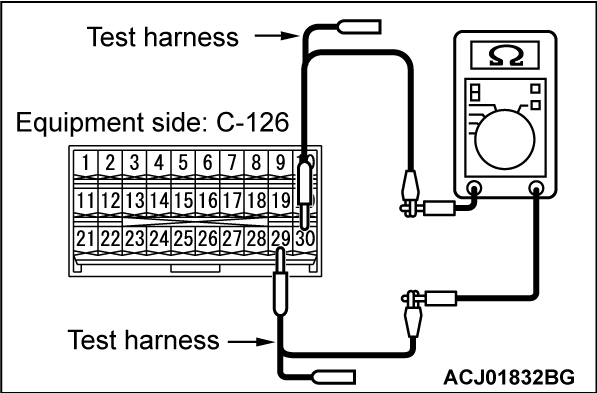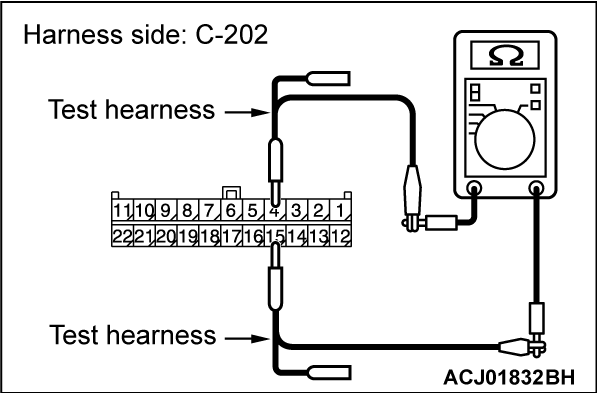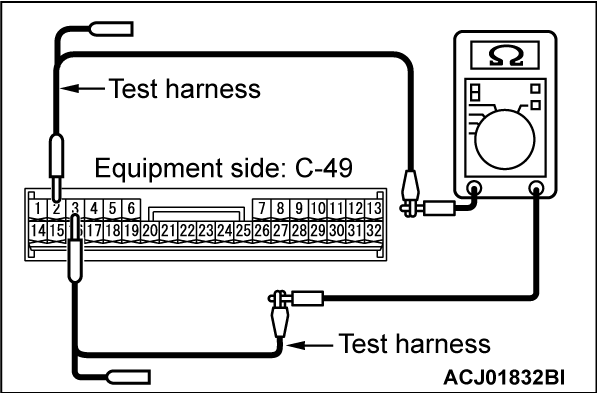DIAGNOSTIC ITEM 5: Diagnose shorts between CAN_H and L lines [CAN-C (Main)].
| caution | When servicing a CAN bus line, ground yourself by touching a metal object such as an unpainted water pipe. If you fail to do, a component connected to the CAN bus line may be broken. |
TROUBLE JUDGEMENT
When all of the following conditions are met, the scan tool MB991958 determines that a short circuit is present between CAN_L and CAN_H lines.
- The scan tool MB991958 cannot receive the periodic transmission data from any ECUs.
- The voltage between CAN-C (Main) bus line (CAN_L and CAN_H lines) is 1.0 volt or more, 4.0 volts or less.
- The resistance at CAN-C (Main) bus line (CAN_L and CAN_H lines) is 2 ohms or less.
TROUBLESHOOTING HINTS
- Malfunction of the wiring harness
- Malfunction of the connector
- Malfunction of the ETACS-ECU
- Malfunction of the steering column switch (steering wheel sensor)
- Malfunction of the AWD-ECU <AWD>
- Malfunction of the occupant classification-ECU
- Malfunction of the FCM/LDW/AHB-ECU <Vehicles with FCM>
- Malfunction of the SRS-ECU
- Malfunction of the TCM
- Malfunction of the ASC-ECU
- Malfunction of the EPS-ECU
- Malfunction of the ECM
- Malfunction of the gateway-ECU
DIAGNOSIS
Required Special Tools:
- MB991223: Harness Set
- MB992006: Extra Fine Probe
STEP 1. Connector check: intermediate connector C-128
| caution | The strand end of the twist wire should be within 10 cm from the connector. For details refer to  . . |
Is the check result normal?
 Repair the defective connector.
Repair the defective connector.STEP 2. Resistance measurement at intermediate connector C-128.
| caution |
(1) Disconnect the connector, and measure at its female-side intermediate connector (at the front wiring harness side).
(2) Turn the ignition switch to the "LOCK" (OFF) position.
(3) Ensure that the negative battery terminal is disconnected.
(4) Resistance between intermediate connector C-128 terminal Nos.13 and 14
OK: 120 ± 20 ohms
Is the check result normal?
STEP 3. Connector check: joint connector (CAN3) C-24
| caution | The strand end of the twist wire should be within 10 cm from the connector. For details refer to  . . |
When checking the joint connector, ensure that its wiring harness side and its short pins are not damaged.
Is the check result normal?
 Repair a defective connector or replace the joint connector.
Repair a defective connector or replace the joint connector.STEP 4. Resistance measurement at joint connector (CAN3) C-24.
| caution |
(1) Disconnect the connector, and measure at the wiring harness side.
(2) Turn the ignition switch to the "LOCK" (OFF) position.
(3) Ensure that the negative battery terminal is disconnected.
(4) Resistance between joint connector (CAN3) C-24 terminal Nos.7 and 18
OK: 120 ± 20 ohms
Is the check result normal?
STEP 5. Resistance measurement at ECM connector B-27.
| caution |
(1) Remove the ECM connector B-27, and measure at the equipment side.
(2) Resistance between ECM connector B-27 terminal Nos.90 and 91
OK: 120 ± 20 ohms
Is the check result normal?
 <Within 120 ± 20 ohms> Repair the wiring harness between joint connector (CAN3) C-24 and the ECM connector B-27.
<Within 120 ± 20 ohms> Repair the wiring harness between joint connector (CAN3) C-24 and the ECM connector B-27. <Not within 120 ± 20 ohms> Check the ECM connector B-27, and repair if necessary. If the ECM connector B-27 is in good condition, replace the ECM.
<Not within 120 ± 20 ohms> Check the ECM connector B-27, and repair if necessary. If the ECM connector B-27 is in good condition, replace the ECM.STEP 6. Resistance measurement at joint connector (CAN3) C-24.
| caution |
(1) Disconnect the connector, and measure at the wiring harness side.
(2) Turn the ignition switch to the "LOCK" (OFF) position.
(3) Ensure that the negative battery terminal is disconnected.
(4) Resistance between joint connector (CAN3) C-24 terminal Nos.5 and 16
OK: 1 kΩ or more
Is the check result normal?
STEP 7. Resistance measurement at TCM connector C-131.
| caution |
(1) Remove the TCM connector C-131, and measure at the equipment side.
(2) Resistance between TCM connector C-131 terminal Nos.9 and 10
OK: 1 kΩ or more
Is the check result normal?
 <1 kΩ or more> Repair the wiring harness between joint connector (CAN3) C-24 and the TCM connector C-131.
<1 kΩ or more> Repair the wiring harness between joint connector (CAN3) C-24 and the TCM connector C-131. <Less than 1 kΩ> Check the TCM connector C-131, and repair if necessary. If the TCM connector C-131 is in good condition, replace the TCM.
<Less than 1 kΩ> Check the TCM connector C-131, and repair if necessary. If the TCM connector C-131 is in good condition, replace the TCM.STEP 8. Resistance measurement at joint connector (CAN3) C-24.
| caution |
(1) Disconnect the connector, and measure at the wiring harness side.
(2) Turn the ignition switch to the "LOCK" (OFF) position.
(3) Ensure that the negative battery terminal is disconnected.
(4) Resistance between joint connector (CAN3) C-24 terminal Nos.8 and 19
OK: 1 kΩ or more
Is the check result normal?
STEP 9. Resistance measurement at ASC-ECU connector A-03.
| caution |
(1) Remove the ASC-ECU connector A-03, and measure at the equipment side.
(2) Resistance between ASC-ECU connector A-03 terminal Nos.11 and 10
OK: 1 kΩ or more
Is the check result normal?
 <1 kΩ or more> Repair the wiring harness between joint connector (CAN3) C-24 and the ASC-ECU connector A-03.
<1 kΩ or more> Repair the wiring harness between joint connector (CAN3) C-24 and the ASC-ECU connector A-03. <Less than 1 kΩ> Check the ASC-ECU connector A-03, and repair if necessary. If the ASC-ECU connector A-03 is in good condition, replace the ASC-ECU.
<Less than 1 kΩ> Check the ASC-ECU connector A-03, and repair if necessary. If the ASC-ECU connector A-03 is in good condition, replace the ASC-ECU.STEP 10. Resistance measurement at joint connector (CAN3) C-24.
| caution |
(1) Disconnect the connector, and measure at the wiring harness side.
(2) Turn the ignition switch to the "LOCK" (OFF) position.
(3) Ensure that the negative battery terminal is disconnected.
(4) Resistance between joint connector (CAN3) C-24 terminal Nos.9 and 20
OK: 1 kΩ or more
Is the check result normal?
 <1 kΩ or more> Repair the wiring harness between joint connector (CAN3) C-24 and the intermediate connector C-128.
<1 kΩ or more> Repair the wiring harness between joint connector (CAN3) C-24 and the intermediate connector C-128.STEP 11. Resistance measurement at EPS-ECU connector C-144.
| caution |
(1) Remove the EPS-ECU connector C-144, and measure at the equipment side.
(2) Resistance between EPS-ECU connector C-144 terminal Nos.5 and 6
OK: 1 kΩ or more
Is the check result normal?
 <1 kΩ or more> Check intermediate connector C-146, and repair if necessary. If the intermediate connector C-146 is in good condition, repair the wiring harness between joint connector (CAN3) C-24 and the EPS-ECU connector C-144.
<1 kΩ or more> Check intermediate connector C-146, and repair if necessary. If the intermediate connector C-146 is in good condition, repair the wiring harness between joint connector (CAN3) C-24 and the EPS-ECU connector C-144. <Less than 1 kΩ> Check the EPS-ECU connector C-144, and repair if necessary. If the EPS-ECU connector C-144 is in good condition, replace the EPS-ECU.
<Less than 1 kΩ> Check the EPS-ECU connector C-144, and repair if necessary. If the EPS-ECU connector C-144 is in good condition, replace the EPS-ECU.STEP 12. Connector check: joint connector (CAN2) C-202
| caution | The strand end of the twist wire should be within 10 cm from the connector. For details refer to  . . |
When checking the joint connector, ensure that its wiring harness side and its short pins are not damaged.
Is the check result normal?
 Repair a defective connector or replace the joint connector.
Repair a defective connector or replace the joint connector.STEP 13. Resistance measurement at joint connector (CAN2) C-202.
| caution |
(1) Disconnect the connector, and measure at the wiring harness side.
(2) Turn the ignition switch to the "LOCK" (OFF) position.
(3) Ensure that the negative battery terminal is disconnected.
(4) Resistance between joint connector (CAN2) C-202 terminal Nos.11 and 22
OK: 120 ± 20 ohms
Is the check result normal?
STEP 14. Resistance measurement at ETACS-ECU connector C-411.
| caution |
(1) Remove the ETACS-ECU connector C-411, and measure at the equipment side.
(2) Resistance between ETACS-ECU connector C-411 terminal Nos.9 and 8
OK: 120 ± 20 ohms
Is the check result normal?
 <Within 120 ± 20 ohms> Repair the wiring harness between joint connector (CAN2) C-202 and the ETACS-ECU connector C-411.
<Within 120 ± 20 ohms> Repair the wiring harness between joint connector (CAN2) C-202 and the ETACS-ECU connector C-411. <Not within 120 ± 20 ohms> Check the ETACS-ECU connector C-411, and repair if necessary. If the ETACS-ECU connector C-411 is in good condition, replace the ETACS-ECU.
<Not within 120 ± 20 ohms> Check the ETACS-ECU connector C-411, and repair if necessary. If the ETACS-ECU connector C-411 is in good condition, replace the ETACS-ECU.STEP 15. Resistance measurement at joint connector (CAN2) C-202.
| caution |
(1) Disconnect the connector, and measure at the wiring harness side.
(2) Turn the ignition switch to the "LOCK" (OFF) position.
(3) Ensure that the negative battery terminal is disconnected.
(4) Resistance between joint connector (CAN2) C-202 terminal Nos.9 and 20
OK: 1 kΩ or more
Is the check result normal?
STEP 16. Resistance measurement at steering wheel sensor connector C-310.
| caution |
(1) Remove the steering wheel sensor connector C-310, and measure at the equipment side.
(2) Resistance between steering wheel sensor connector C-310 terminal Nos.3 and 4
OK: 1 kΩ or more
Is the check result normal?
 <1 kΩ or more> Repair the wiring harness between joint connector (CAN2) C-202 and the steering wheel sensor connector C-310.
<1 kΩ or more> Repair the wiring harness between joint connector (CAN2) C-202 and the steering wheel sensor connector C-310. <Less than 1 kΩ> Check the steering wheel sensor connector C-310, and repair if necessary. If the steering wheel sensor connector C-310 is in good condition, replace the steering column switch (steering wheel sensor).
<Less than 1 kΩ> Check the steering wheel sensor connector C-310, and repair if necessary. If the steering wheel sensor connector C-310 is in good condition, replace the steering column switch (steering wheel sensor).STEP 17. Resistance measurement at joint connector (CAN2) C-202.
| note | Step 17 and 18 are only for AWD. On vehicles without it, go to Step 19 . . |
| caution |
(1) Disconnect the connector, and measure at the wiring harness side.
(2) Turn the ignition switch to the "LOCK" (OFF) position.
(3) Ensure that the negative battery terminal is disconnected.
(4) Resistance between joint connector (CAN2) C-202 terminal Nos.8 and 19
OK: 1 kΩ or more
Is the check result normal?
STEP 18. Resistance measurement at AWD-ECU connector C-228.
| caution |
(1) Remove the AWD-ECU connector C-228, and measure at the equipment side.
(2) Resistance between AWD-ECU connector C-228 terminal Nos.5 and 13
OK: 1 kΩ or more
Is the check result normal?
 <1 kΩ or more> Check intermediate connector C-27, and repair if necessary. If the intermediate connector C-27 is in good condition, repair the wiring harness between joint connector (CAN2) C-202 and the AWD-ECU connector C-228.
<1 kΩ or more> Check intermediate connector C-27, and repair if necessary. If the intermediate connector C-27 is in good condition, repair the wiring harness between joint connector (CAN2) C-202 and the AWD-ECU connector C-228. <Less than 1 kΩ> Check the AWD-ECU connector C-228, and repair if necessary. If the AWD-ECU connector C-228 is in good condition, replace the AWD-ECU.
<Less than 1 kΩ> Check the AWD-ECU connector C-228, and repair if necessary. If the AWD-ECU connector C-228 is in good condition, replace the AWD-ECU.STEP 19. Resistance measurement at joint connector (CAN2) C-202.
| caution |
(1) Disconnect the connector, and measure at the wiring harness side.
(2) Turn the ignition switch to the "LOCK" (OFF) position.
(3) Ensure that the negative battery terminal is disconnected.
(4) Resistance between joint connector (CAN2) C-202 terminal Nos.2 and 13
OK: 1 kΩ or more
Is the check result normal?
STEP 20. Resistance measurement at occupant classification-ECU connector D-48-2.
| caution |
(1) Remove the occupant classification-ECU connector D-48-2, and measure at the equipment side.
(2) Resistance between occupant classification-ECU connector D-48-2 terminal Nos.12 and 14
OK: 1 kΩ or more
Is the check result normal?
 <1 kΩ or more> Check the intermediate connectors C-17 and D-48, and repair if necessary. If the intermediate connectors C-27 and D-48 are in good condition, repair the wiring harness between joint connector (CAN2) C-202 and the occupant classification-ECU connector D-48-2.
<1 kΩ or more> Check the intermediate connectors C-17 and D-48, and repair if necessary. If the intermediate connectors C-27 and D-48 are in good condition, repair the wiring harness between joint connector (CAN2) C-202 and the occupant classification-ECU connector D-48-2. <Less than 1 kΩ> Check the occupant classification-ECU connector D-48-2, and repair if necessary. If the occupant classification-ECU connector D-48-2 is in good condition, replace the occupant classification-ECU.
<Less than 1 kΩ> Check the occupant classification-ECU connector D-48-2, and repair if necessary. If the occupant classification-ECU connector D-48-2 is in good condition, replace the occupant classification-ECU.STEP 21. Resistance measurement at joint connector (CAN2) C-202.
| note | Step 21 and 22 are only for vehicles with FCM. On vehicles without it, go to Step 23 . . |
| caution |
(1) Disconnect the connector, and measure at the wiring harness side.
(2) Turn the ignition switch to the "LOCK" (OFF) position.
(3) Ensure that the negative battery terminal is disconnected.
(4) Resistance between joint connector (CAN2) C-202 terminal Nos.5 and 16
OK: 1 kΩ or more
Is the check result normal?
STEP 22. Resistance measurement at FCM/LDW/AHB-ECU connector E-18.
| caution |
(1) Remove the FCM/LDW/AHB-ECU connector E-18, and measure at the equipment side.
(2) Resistance between FCM/LDW/AHB-ECU connector E-18 terminal Nos.2 and 8
OK: 1 kΩ or more
Is the check result normal?
 <1 kΩ or more> Check intermediate connector C-226, and repair if necessary. If the intermediate connector C-226 is in good condition, repair the wiring harness between joint connector (CAN2) C-202 and the FCM/LDW/AHB-ECU connector E-18.
<1 kΩ or more> Check intermediate connector C-226, and repair if necessary. If the intermediate connector C-226 is in good condition, repair the wiring harness between joint connector (CAN2) C-202 and the FCM/LDW/AHB-ECU connector E-18. <Less than 1 kΩ> Check the FCM/LDW/AHB-ECU connector E-18, and repair if necessary. If the FCM/LDW/AHB-ECU connector E-18 is in good condition, replace the FCM/LDW/AHB-ECU.
<Less than 1 kΩ> Check the FCM/LDW/AHB-ECU connector E-18, and repair if necessary. If the FCM/LDW/AHB-ECU connector E-18 is in good condition, replace the FCM/LDW/AHB-ECU.STEP 23. Resistance measurement at joint connector (CAN2) C-202.
| caution |
(1) Disconnect the connector, and measure at the wiring harness side.
(2) Turn the ignition switch to the "LOCK" (OFF) position.
(3) Ensure that the negative battery terminal is disconnected.
(4) Resistance between joint connector (CAN2) C-202 terminal Nos.3 and 14
OK: 1 kΩ or more
Is the check result normal?
STEP 24. Resistance measurement at SRS-ECU connector C-126.
| caution |
(1) Remove the SRS-ECU connector C-126, and measure at the equipment side.
(2) Resistance between SRS-ECU connector C-126 terminal Nos.30 and 29
OK: 1 kΩ or more
Is the check result normal?
 <1 kΩ or more> Repair the wiring harness between joint connector (CAN2) C-202 and the SRS-ECU connector C-126.
<1 kΩ or more> Repair the wiring harness between joint connector (CAN2) C-202 and the SRS-ECU connector C-126. <Less than 1 kΩ> Check the SRS-ECU connector C-126, and repair if necessary. If the SRS-ECU connector C-126 is in good condition, replace the SRS-ECU.
<Less than 1 kΩ> Check the SRS-ECU connector C-126, and repair if necessary. If the SRS-ECU connector C-126 is in good condition, replace the SRS-ECU.STEP 25. Resistance measurement at joint connector (CAN2) C-202.
| caution |
(1) Disconnect the connector, and measure at the wiring harness side.
(2) Turn the ignition switch to the "LOCK" (OFF) position.
(3) Ensure that the negative battery terminal is disconnected.
(4) Resistance between joint connector (CAN2) C-202 terminal Nos.4 and 15
OK: 1 kΩ or more
Is the check result normal?
 <1 kΩ or more> Repair the wiring harness between joint connector (CAN3) C-24 and the intermediate connector C-128.
<1 kΩ or more> Repair the wiring harness between joint connector (CAN3) C-24 and the intermediate connector C-128.STEP 26. Resistance measurement at gateway-ECU connector C-49.
| caution |
(1) Remove the gateway-ECU connector C-49, and measure at the equipment side.
(2) Resistance between gateway-ECU connector C-49 terminal Nos.3 and 2
OK: 1 kΩ or more
Is the check result normal?
 <1 kΩ or more> Repair the wiring harness between joint connector (CAN2) C-202 and the gateway-ECU connector C-49.
<1 kΩ or more> Repair the wiring harness between joint connector (CAN2) C-202 and the gateway-ECU connector C-49. <Less than 1 kΩ> Check the gateway-ECU connector C-49, and repair if necessary. If the gateway-ECU connector C-49 is in good condition, replace the gateway-ECU.
<Less than 1 kΩ> Check the gateway-ECU connector C-49, and repair if necessary. If the gateway-ECU connector C-49 is in good condition, replace the gateway-ECU.![[Previous]](../../../buttons/fprev.png)
![[Next]](../../../buttons/fnext.png)

